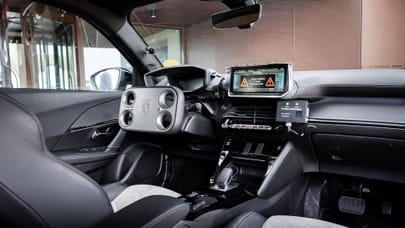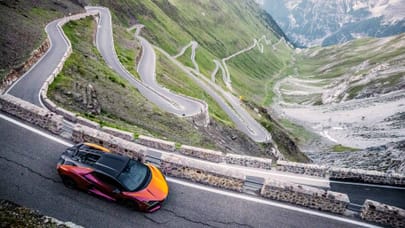
James May on the future of transport
Some weeks ago, I re-read Arthur C Clarke’s book Profiles of the Future, which he describes as ‘an enquiry into the limits of the possible’. It’s a heady mix of, at one extreme, the rather far-fetched and, at the other, the sort of thing that elicits an involuntary snort of incredulity. Well worth a few hours spent on the canvas of a deckchair.
Ol’ Clarkey has some interesting views on teleporting, inter-galactic spaceships, time travel and all the usual stuff that dwells deep in the black hole of sci-fi awaiting a more concrete explanation. A little dodgy some of it may be, but underneath he’s all right is Arthur.
But the most gratifying aspect of the book is this: that on the subject of the future of personal transport, the aged sage is in broad agreement with that other renowned visionary and sometime writer of complete fiction, James May. I said, a few months ago, that our descendants would float about the sky in levitating capsules; so says Mr Clarke, and he actually seems to know what he’s on about.
There’s always a chance, of course, that we’re merely both wrong. Challenging the intellectual colossus that is the May/Clarke school of urban transportation prediction is my mate John, owner of the world’s most knackered Peugeot 405.
This is a car with no effective rear seat, since it’s taken up with bits of the car that formerly featured on its exterior. The inside of John’s car is more grubby than the underneath of mine. And if you can persuade the fan to come on, a lot of dead spiders are blown into the cabin.
Here is a man who should really buy a new car, but who is instead keen to advance the local transport strategy debate. Well, the other day he came around, waving my piece on the future of personal mobility above his head and announcing triumphantly that it was ‘complete cobblers’.
He had seen the future of the car, it was almost upon us, and it would take the form of the dodgem. My first reaction was to assume that he’d fallen out of the pub, staggered into the fun-fair currently operating on the local common, and then viewed the whole business through a particularly thick pair of beer goggles. But then, when I thought about it a bit harder, I realised that his reasoning was quite sound.
The beauty of the dodgem – John has coined the acronym OPV, for Overhead-Powered- Vehicle – is that its power source is centralised, thus allowing the individual car to be simple and hence cheap. Localised pollution will be virtually banished and if the central electricity supply is provided by some clean and self-sustaining means such as nuclear fusion or a big hydrogen fuel cell, then all the political and ecological credentials of the whole infrastructure will be up there with a jar of Linda McCartney fair-trade GM-free South African peace chutney.
Any old people reading this will immediately point out that we’ve had a type of OPV before – the trolley bus. This is different. The trolley bus was not only a bus and hence offensive to all forward-thinking people, it could also only go where a few dangling overhead wires allowed it. In John’s dodgem scenario, overhead power is pretty much everywhere and available to all.
Top Gear
Newsletter
Thank you for subscribing to our newsletter. Look out for your regular round-up of news, reviews and offers in your inbox.
Get all the latest news, reviews and exclusives, direct to your inbox.
Now I’ve always been a bit of a duffer where electricity is concerned, but I’m pretty sure of how a dodgem works. It collects electricity from an overhead supply via a piece of tinfoil on a stick and then returns it through earth; that is, the metal plates on the floor. So presumably every bit of road, right up to and including the floor of your garage, would have to be clad in steel.
But John points out – fairly, it has to be said – that the cost of this will be greatly offset by the reduction in the road repair budget. The surface will be immensely tough and hard-wearing and in any case the vehicles will be very light.
The city, meanwhile, will surely be very dark, because it will be shrouded by a huge canopy supported by gaily-coloured poles with flashing lights on. My detractor suggests that only the main roads will be provided with overhead power, that it will take the form of a light mesh and that we will simply push our lightweight cars onto the grid. As he owns the worst car in the world, I can sort of see where he got the inspiration for this bit.
It all makes more sense than I like to admit, given that I’ve backed anti-gravity so emphatically. The automotive technology of the electric car is already fully worked out – has been for a lifetime, in fact. The only significant remaining problem is the inadequacy of current batteries and the subsequent low power, poor range and recharging problems. The dodgem solution frees designers from this tyranny because it’s an electric car that, in effect, runs straight from the mains. And whilst nuclear fusion is still under development, we rely on noisy, belching, stinking roadside diesel generators last serviced in 1960.
Er... hang on. Once we view this hypothesis in its correct context, i.e. the fairground, it begins to look about as promising as the life expectancy of that goldfish you just won. For a start, the roads will be mayhem, as there’ll always be some berk trying to impress his bird by going round the wrong way in direct contravention of the signs. There’ll be a crash every 10 yards and if you’re not held up by that, you’ll be held up by the old dear whose dodgem won’t move as she’s got the steering wheel turned so far that it’s trying to go backwards. I’m also not sure I could drive all day to the accompaniment of old Lieutenant Pigeon records on a scratchy hi-fi and a man shouting “Hold on tight, ladies” over the PA system.
Then there’s a serious manpower issue. Currently, we buy petrol, pay a huge tax on it, and the government allegedly uses it for the upkeep of our roads. With dodgems, every local council in the land will have to employ hundreds of hairy-arsed neanderthals to leap onto the back of your car every five minutes and demand another two quid.
Nah. On second thoughts, anti-gravity it is.
Trending this week
- Car Review
BMW iX3








